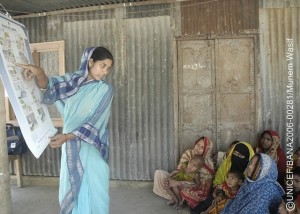Drowning in numbers
2012-05-23
| FLORENCE/ GENEVA/ BANGKOK/ DELHI/ HONG KONG, 23 May 2012 – A new report states that although drowning is a leading killer of children across parts of Asia, highly effective and cost-efficient programs to reduce such drowning deaths are not being sufficiently emaced. Child Drowning: Evidence for a newly recognized cause of child mortality in low and middle income countries in Asia surveyed four countries (Bangladesh, Cambodia, Vietnam & Thailand), together with two provinces in China (Beijing and Jiangxi). |
Ms Maggie Cheung, the UNICEF Ambassador in China visited Jiangxi to know more about child drowning. |
“For too long drowning has been a hidden killer,” said Gordon Alexander, the Director of UNICEF’s Office of Research. “Over the past three decades countries have made strong, continuous progress on infectious disease reduction. However no impact has been made on drowning deaths. As a result, drowning is emerging as a leading cause of death for children after infancy (1year) in the countries surveyed for this report. And yet drowning is off the political radar.”
The report finds that the vast majority of the drowning deaths are preventable. They tend to occur within 20 metres of the home and are the result of unsupervised children wandering off and falling into local water hazards.
The report includes new evidence into prevention interventions in an operational research program in Bangladesh, showing:
- Drowning death rates among children attending village crèches were reduced by more than 80 per cent as a direct result of having adequate supervision.
- Drowning death rates in children 4 years and older who participated in SwimSafe (swimming and safe rescue training) were reduced by more than 90 per cent.



UNICEF’s Gordon Alexander said the research suggests governments and development agencies can do more to support drowning prevention interventions through scaling up early childhood education/crèche programmes, and with improved integration with ongoing public health, education and disaster risk programmes, together with better mapping of the true prevalence of drowning.
“This report makes clear that there is a serious – and until now, hidden – problem in the countries surveyed. It also provides evidence of affordable interventions that can save hundreds of thousands of children’s lives. We must now act where we have the evidence, and investigate whether similar underreporting and preventable deaths are happening elsewhere.”
Click here to read the full report









